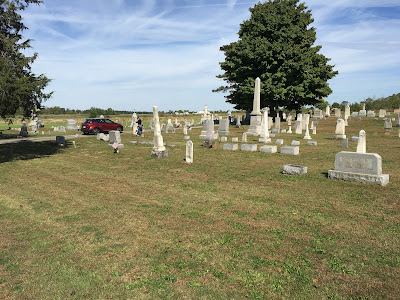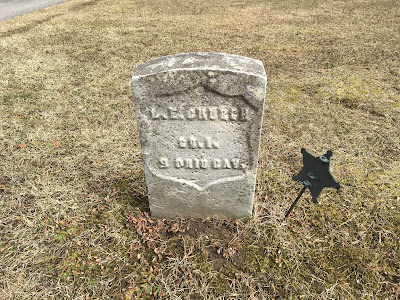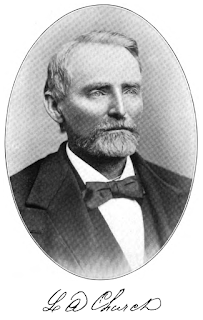My search for the one-armed man began with an email from a cousin Amie - 4th cousin once removed, to be precise - asking about a certain Catherine Collins. To orient you, we're on my mother's side of the family, all Irish. Specifically, it's Hannah Driscoll's side of the family (my maternal grandmother's mother). The focus of Amie's question, Catherine Collins, was Hannah's first cousin, the daughter of her uncle Peter Collins (1838-1923). Amie had had a hard time finding records for Catherine and was curious if I might be able to contribute.
My first concern was to verify that the information that I did have was accurate. I had been exploring the Oswego connections very early in my family history research and hadn't pursued it recently. To be frank, I wasn't entirely confident that what I thought I knew was really true. I had made the link from my 2nd great grandmother Ellen (Collins) Driscoll to Catherine's father, Peter, through a line in Ellen's obituary:
She is survived by four sons, Jeremiah, Timothy, Daniel and Michael of this city [Oswego, New York] and two daughters, Mrs. Patrick Cotter, Ireland, and Mrs. Frederick Bough; also a brother, Peter Collins of this city.
I was a bit concerned that the Peter Collins I'd latched on to wasn't actually Ellen's brother, but just another guy with the same common name. Actually, the fact the Amie found me should have been reassuring: it turns out that there's a DNA match between the two of us. With that independent confirmation of a relationship I was much more confident that I'd found the right Peter.
Catherine Collins was baptized on 20 Aug 1865, the child of Peter Collins and Bridget Heagerty, in Skibbereen, County Cork. I'm not sure when she emigrated to the U.S., but she married a man named Luther E. Church on 04 Dec 1885 in Fulton, New York. I also found her name mentioned in the obituary of her son, Thomas D. Collins, who died 20 Sep 1945 in Syracuse, New York. As a sharp-eyed reader, I'm sure that you've caught the fact that Thomas used his mother's maiden name Collins, and not Church.
Baptismal record for Catherine Collins from the parish registers of Skibbereen parish.
So this was the state of my records when Amie contacted me, and that prompted me to dig a little deeper. I found conflicting stories about Luther Church and Katy Collins, and I thought that I would let you be the judge and decide which one you believe. Let's begin with Luther Church, as that's the side with the most detailed paper record.
Luther Church
Luther Church was born in Ohio in 1848 to Daniel Church and Sarah Anne Harvey. The family had moved to Ohio from New England (Massachusetts and Connecticut). He had 5 sisters and 2 brothers: Luke Ancil, Sarah Jane, Elizabeth, Adeline, Almina, Eli, and Sophia. In 1850 they were living in Scipio Township in Seneca County, Ohio. That's about an hour to the north of where I live in Columbus. On 03 Oct 1863 Luther and his brother Eli both volunteered to join Company I of the 9th Ohio Cavalry. A little arithmetic, and we see that Luther was not 18 years old as he claimed (and as Lieutenant Turner confirmed), but only 14!Luther's army career was short-lived. Here is his account as related in a deposition in 1865 (with some punctuation and capitalization edited):
...while with and acting as a private in said Co & Rgt [Company I of 9th Ohio Volunteer Cavalry] at Decatur Alabama. Early in the morning of the first day of June 1864 they were attaked by Rebell Cavalry or an alarm given in the Union camp when hasty orders were given for his company to saddle. When he in attempting to get his saddle out from an old building said saddle having a carobine lashed to it in attempting to pick up or draw his said saddle to him the cock of said carobine ketched and drew it back so that when it come loos it caused the carobine to explode and sent its contents through his left arm near the shoulder nearly severing the arm from the shoulder. He was immediately taken to the General Hospital where his arm was amputated about one hour after the accident. That he was in line of duty and trying to obey his commanding officers at the time of the accident.
This account was corroborated by Sergeant Rush P. Baldwin later, interestingly using many of the same words:
"Rush P. Baldwin ... says that he is a sargent in Co. I of the 9th Ohio Volunteer Cavalry. That he was with and had command of a detachment from said Co. & Regt. on or about the first day of June 1864. They was then at Decatur in the State of Alabama and on or about said first day of June 1864 Luther E. Church, a private in said Co. & Rgt. was shot through the left arm near the shoulder by accident. Which happened as follows to wit - We camped over knight in a building. The next morning orders was given to saddle. When said Luther E. Church in attempting to pickup his saddle which had a carobine lashed to it, the cock of which kitched, and in picking up or drawing said saddle to him drawed the cock back and caused said carobine to explode and send its contents through the left arm of said Luther E. Church making a bad wound and rendering amputation necessary. He said Luther E Church being in line of duty at the time of the accident."
Luther's arm was amputated in its upper third, leaving a stump that was not long enough for him to later be fitted with an artificial arm. He was moved from the General Hospital in Decatur to another one in Nashville; Tennessee; then on to Madison, Indiana; and finally to Camp Dennison in Ohio (near Cincinnati). There he was formally discharged on 29 Oct 1864, just a bit over a year since he volunteered.
After his discharge, Luther applied for and received a pension from the federal government. His justification was that he was an orphan (his father having died in 1858), his mother was in indigent conditions, and he was unable to work because of the loss of his left arm. The application was approved, and the pension began retroactively to his date of discharge at the princely sum of $8 per month. Most of these details are drawn from his pension file from the U.S. Archives, a file that is 101 pages long. That length is primarily due to the fact that Luther seemed to be constantly applying for an increase in the amount he received each month. As far as I can tell none of these requests were approved, but over the years Congress did raise veterans' pensions: In 1866 Luther's income was raised to $15/month; in 1872 to $18; in 1874 to $24; 1883 to $30, 1886 to $45; and, finally, in 1903 his payments were increased to $55 per month. During most of his life Luther lived in north central Ohio, in Seneca County in Tiffin and Republic. There is an interlude, though, when he was in central New York, at least from 1875 to 1889. I haven't been able to figure out what he was doing there, but this will be an important part of my tale.
The applications for pension increases became more plaintive over time. Luther truly suffered, of that I am sure. How much his ailments were the result of the loss of his arm is much less certain. Toward the end of his life he was restricted to a chair. Because of dropsy, he was even unable to lie down to sleep as his lungs would fill with fluid. He died on 30 Dec 1903 in Tiffin and was buried in Farewell Retreat Cemetery in the nearby town of Republic.
The life of Luther Church was notable not only for his Civil War service, but for his married life as well... his marriages.
The Three Wives of Luther Church
In 1898 the Bureau of Pensions included an additional form to be completed by the pensioner in which information was requested concerning marriage status and children. The first question was "Are you married?" Luther dutifully reported that he was married to Pearl (Bidleman) Church, and that their marriage took place on 12 Jul 1894 in the Methodist Episcopal Church in Tiffin, presided over by the Rev. McKibbins. With the fourth question, the answers become even more interesting: "Were you previously married?" It turns out that Luther had plenty of information to pass on here. He reported that he had been married to "Maggie E. Church via Harding" in 1872, and that they divorced in 1877. Further, he had later married my cousin, Kate Collins, in 1886, and they divorced in 1887. Finally, concerning any children, Luther reported "One boy living, 2nd wife, 12 years old, July 4th in Oswego NY. With his grandmother Bridget Collins. Raised him for me until 16 years of age."That sounds straightforward, but in fact Luther's record with the wedded state was much more complicated. My first hint of this came when I found a document recording that in 1887 he had been sentenced to two years in the Onondaga County Penitentiary for the crime of ... bigamy. Apparently the report that he'd divorced first wife Maggie was a bit of wishful thinking. It took me some time to find any records of that first marriage. Luther married Margaret E. Harding (born 1861) in Dryden, New York on 08 Sep 1875. Dryden is a small town about 43 miles (69 km) south of Syracuse and 13 miles (22 km) to the east of the college town of Ithaca. Five years later, in the 1880 census, they were living in Barton, New York, a town 32 miles (52 km) south of Ithaca near the Pennsylvania border. The next record I have for Luther is his marriage to Kate Collins in Fulton, New York. This is another small town but on the opposite side of Syracuse, about 30 miles (48 km) to the northwest, and only 11 miles (17.5 km) southeast of the port city of Oswego.
I'm not sure if a conviction of bigamy automatically comes with one or more divorces, but the date of his divorce from Kate corresponds to the beginning Luther's term in the Onondaga County Penitentiary. (I guess Oswego County didn't have an appropriate jail, so he was sent to the Syracuse area.) He didn't serve the full two year sentence, though. On 06 Feb 1889 his sentence was commuted to time served - 1 year, 4 months, and 16 days - by order of the Governor of New York, David B. Hill (that's his official portrait to the right). The commutation was made under one condition, that is that "Luther E. Church shall totally abstain from the use of intoxicating liquors for the period of five years...." Although the Governor has the power to commute or pardon, he also is obliged to state the reasons for his decision to the Legislature. Governor Hill's justification for Luther's commutation gives one side of the story:The facts of this case, as reported to me, are, that some six years before the commission of the offense, prisoner's wife left him for another man with whom she has been living ever since. He was induced, while intoxicated, to marry the complainant, a woman of notoriously bad character, who, after living with him for two or three years, deserted him and became an inmate of a house of ill-fame, and, it is alleged, preferred a charge of bigamy against him, in order to rid herself of his importunities to return to him. His offense resulted in no private injury and the law has been fully vindicated by the time served.
Unpacking this, the information given to the Governor was that on or about 1879 (six years before he married Kate Collins and thereby committed bigamy) Luther's first wife, Maggie, left him. This is inconsistent with the 1880 census record, but it's within a year so it might be only a rounding error. I haven't yet been able to determine who this second man was. Hill's statement then gets into a bit of character assassination. He doesn't name names, but clearly the "woman of notoriously bad character" was Kate Collins, that she "induced" Luther into marriage, and then later became a prostitute. Nothing is said about the fact that there was a child involved: Tom was born on the Fourth of July, 1886. Thus, I find the assertion that the offense resulted in no private injury a bit hard to swallow.
So, was Luther Church the hapless victim of an evil woman and his love for the liquor? There are a few more items that might influence your opinion. These were gleaned from the newspapers in Oswego. Luther Church isn't a particularly common name, and in fact, there was another man by that name who lived in the area near Saratoga, New York at the same time. Identification of my target was made easier by the fact that the reporters often added a little bit of color to their story by referring to Luther's missing arm.
- From the Oswego Palladium, 26 Jun 1886: "Luther E. Church, charged with using profane and obscene language in public, pleaded not guilty; over until 4.30."
- From the Oswego Daily Times Express, 10 Sep 1886: "Luther E. Church was arranged [sic] on a charge of assault on his wife. He is a one armed man and frankly admitted committing the offence while intoxicated. Recorder Bulger asked him if he had reported around that he, Recorder Bulger, had given him $50 with which to buy votes for him and this charge Mr. Church indignantly denied, although his mother-in-law [Bridget Heagerty Collins], who was present, insisted that he had made the statement. There was quite a lively time in the court room until Recorder Bulger put and end to it by giving him a sentence of 59 days in the county jail."
- From the Oswego Palladium, 08 Nov 1886: "Luther E. Church, charged upon complaint of his wife with non-support, pleaded not guilty. Convicted and held to $300 bail or six months in the county jail for the future maintenance of his wife and family. In default of bail he was sent to jail. Church, according to his own statement receives a pension of $45 per month from the government. His wife says he spends the most of it for rum. The charge of petit larceny made against Church was adjourned for six months."
- From the Oswego Palladium, 28 Dec 1886: "Luther E. Church was arrested yesterday on complaint of his wife charged with being a disorderly person and failing to support herself and child. He pleaded guilty and was allowed to go on condition that he furnished board and paying to his wife three dollars a week.
Unfortunately, that's where I have to leave the story of Kate Collins. I haven't been able to find anything else about her. She is not in the 1888 or 1899 city directories for Oswego (the ones available online to me), nor in the directories for 1903 and later in Fulton. She is not in the 1900 census that I can find. Her son is, though, under the name Thomas Church and living with his grandparents Peter and Bridget Collins. According to the website findagrave.com there is a Catherine Collins buried in St. Paul's Cemetery in Oswego, but no other information is provided other than her age of 66 years. I haven't been able to figure out who that person is. We were unsuccessful in our search for that grave when we visited St. Paul's in October, even though we knew it was in Section J. In sum, I guess I didn't succeed in helping Amie much to flesh out the life of Catherine Collins. There surely were a lot of interesting detours on the way though!
Detours
Luther Church's eldest brother, Luke Ancil Church (1831-1901) moved to California in 1851 where he worked as a prospector, miner, a stage driver, and a hotel owner. His hotel was in a place called Don Pedro Bar, an area that is now lost under the waters of Don Pedro Lake. He moved from there to Paradise, in the process taking the wood from his old hotel to build his house there. In 1870 he then moved that house to the new settlement of Modesto, the third house in the town. That house still stands to this day.Luther's other brother did not fare so well (if that's the right word). He volunteered for the Union cause at the same time as Luther, and so was also in Company I of the 9th Ohio Volunteer Cavalry. He died of typhus fever on 27 Apr 1864 in the Regimental Hospital in Nashville, Tennessee.













